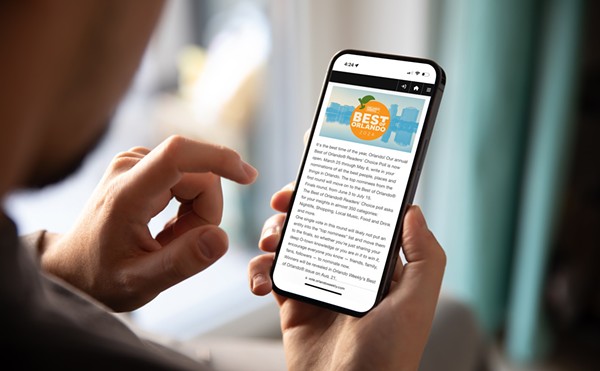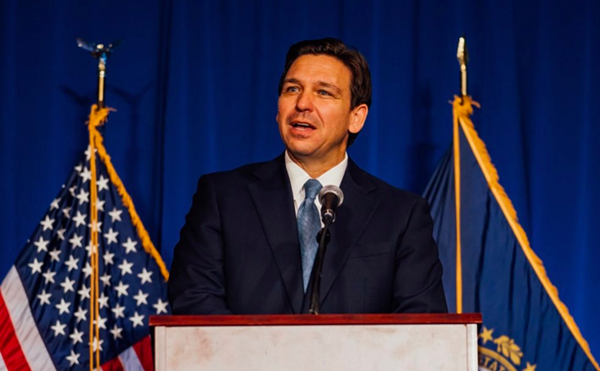Push me, poll you.
I hadn’t merited one of those fancy monitor boxes; instead, Nielsen had merely sent along a humble softbound diary and asked me to record all of my program choices for the ensuing week. (They had also enclosed, for my trouble, the crispest, newest one-dollar bill I had ever seen – thus instilling in me the delightfully paranoid fantasy that they somehow enjoyed a direct line to the United States Treasury.)
Faced with this once-in-a-lifetime opportunity to help craft a more accurate portrait of our nation’s most important communications medium, I did what any red-blooded, civic-minded young fellow would have done: I lied like a bastard. Had I registered my viewing preferences honestly, my diary would have been filled with titles like MTV’s Spring Break Bikini-thon and Metalfest. Those shows didn’t need my help; everybody in America was already watching them. Instead, I simply grabbed a TV Guide, looked up what was playing on PBS in any given time slot, and wrote it down. You’re welcome, Bill Moyers.
Yep, back in those days, you could really game the system for the public good. Now we’re largely off the buddy system, and services like Nielsen have all kinds of technologically advanced doohickeys to help them determine what we’re watching. But “what” is only one of the five W’s and an H your journalism teacher told you about. There’s also “how,” which is something Nielsen has had more of a problem with. And they know it, which is why they’re making such a big deal about adding streaming data to their evaluations later this year. Come September, services like Netflix, Amazon and Xbox will be included in their tabulations of viewership numbers, alongside the traditional broadcast, cable and satellite transmissions. They’re even planning on factoring in iPads, slowly but surely. (Coming in 2025: Etch-a-Sketch!)
This is all very exciting news, for an obvious reason: Next season, we’ll be able to tell which shows America would have watched had the current network lineups all been available back in 2008. Simply put, the tools we use to enjoy televisual entertainment remain far ahead of the tools we use to measure it. Programs still live or die based on a rating metric that doesn’t begin to take into account the many ways in which people “watch TV.” And going back to J-school for a minute, the “when” element is really taking it up the wazoo: Even in the DVR era, Nielsen only counts programs that are viewed within three days of their initial offering. That seems to discriminate heavily against those with busy lifestyles and the incorrigibly lazy alike. (Without specifying which of those groups I happen to fall into, let’s just say that I’ve waited more than a week to watch shows I’m pretty sure I might have been in.)
The ghost of Jimmy the Greek was heard to weep bitterly.
For a society that purports to revolve around public opinion, we sure have trouble weighing it sometimes. For further proof, look at all the polling firms that got their asses kicked trying to call the last election. Most of the most venerable names in the business were tarnished by data that showed a horse race far closer than what the Nate Silvers of the world were predicting; when all the results were in, the most accurate assessments had come from younger, progressive outfits like Public Policy Polling, while more established operations like Zogby and Rasmussen had done a great job of making Dick Morris look like Nostradamus. When Gallup isn’t even good enough for USA Today, you know there’s a problem with our surveying traditions.
To an extent, this merely reinforces Stephen Colbert’s assessment that reality has a known liberal bias. But it also says a lot about the methodologies involved, and whom they favor. Crazy as it sounds, until the very last minute, our major media outlets remained partnered with firms that only polled Americans with land-line phones, yet they treated those samples as somehow representative of the citizenry at large. To go back to the Nielsen situation, this is like basing your TV ratings entirely on the tastes of people old enough to still have the phrase “I wanted to see it, but I missed it” in their viewing lexicon.
We don’t have to “miss” programs anymore, nor do we live in a right-wing echo chamber where Gladys has to put down the Princess phone to ask her husband whom they’re both voting for. The mainstream, supposedly liberal media has been remarkably slow to recognize those changes, especially the latter one. Partially, this is by choice: Their ratings-grabbing strategies depend on the concept of a perpetual neck-and-neck battle between two combatants of roughly equal potency. Acknowledging that we now have only one national political party and one highly unpopular regional fringe group is hard for them; they don’t know how to tell that story. Instead, it’s been more comfortable for them to rely on extremely limited, drastically outmoded opinion sampling that shows a “divided America.” Which, in turn, enables them to grab a bigger slice of a ratings pie they can’t trust either, because its parameters are likewise ridiculously obsolete. Talk about your Sisyphean jobs.
[image-3]
Cheer up! You totally swept the VCR owners.
The lesson here is that, as we travel together down the path of our national destiny, we’re always a few steps farther along than we’re led to believe. The pollsters are always playing catch-up with the true mood and tenor of the country. The lag is even worse in times of profound demographic and technological advancement, like the one we’re experiencing now: At moments like this, changes accrue logarithmically, not arithmetically.
That’s pretty unfortunate if you like your democracy -- or even just your mass entertainment -- to reflect the actual will of the people as closely as possible. But on the bright side, there’s something charming about it if you don’t like the idea of some glorified salesman always knowing just what you’re thinking. Pollster disconnect can even be reassuring, if you’re just enough of an anarchist to see some value in keeping Madison Avenue guessing.
About a year after my Nielsen adventure, I received yet another solicitation from them, including another viewing diary and another crisp dollar bill. Friends in the broadcast business told me this was never supposed to happen: Nielsen, they said, took pride in making sure every American household was only polled once. For a minute, I grinned wider than fucking Abbie Hoffman. Then I ran for my TV Guide to find out when NOVA was on.




















